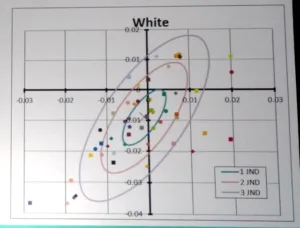Matt Cowen of Entertainment Technology Consultants, talked about metamers. He explained that when you move from broadband primaries, for example, from a Xenon lamp, to very narrow band primaries, as seen in RGB laser projectors, you can introduce metameric failure. That means, that colors that would be judged the same by two people with the Xenon light source might be judged differently when using an RGB laser source – even though an instrument says they are the same color.

Cowen noted that there is quite a bit of variability in the RGB response curves for the human eye, as shown in the widening of the curves of the population model vs. the standard observer. The RGB laser primaries are overlaid to illustrate how metameric failure can happen.
He then described a color matching experiment that recorded the colors seen by 20 observers and 13 colors using Xenon and RGB laser illumination. The results, shown in the chart, suggest that most were able to match the colors to within 3 JNDs (just noticeable difference) and is likely to be a result of the cone differences of the observers. A JND of 3 is a pretty good result for non-professionals.
He concluded that while the differences are real, there are no real practical consequences from using the RGB laser projectors. There are 500 such systems deployed in cinemas to date and there have “been no reported issues with metamerism in the theaters.” This should help end the debate about metameric failure in theaters for general audiences, but it does not end the debate in the mastering suite where a JND of 3 is unacceptable.- CC

